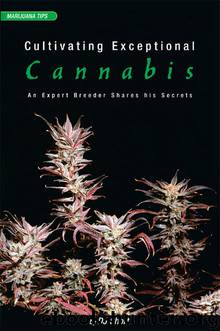Cultivating Exceptional Cannabis: An Expert Breeder Shares His Secrets (Marijuana Tips Series) by DJ Short

Author:DJ Short
Language: eng
Format: mobi
ISBN: 9781936807123
Publisher: Quick Trading Company
Published: 2004-01-31T00:00:00+00:00
DJ Short’s
Flavor & Olfaction Chart
* * *
The range of flavors and aromas expressed by the genus cannabis is extraordinary. This chart shows the various families of taste and smell that are possible to achieve. Exceptional cannabis often bridges multiple catagories, creating a complex sensory experience.
Download D.J. Short’s Aroma Chart
SECTION II
The Art of Breeding
13
The Art of Selection
The most important factor in breeding quality cannabis is selection. Selective breeding has resulted in today’s varieties. The first stock that breeders had to work with were land-race Sativa varieties. These equatorials were seeded, which facilitated breeding. Indica genetics (Afghan, Kush and Skunk, to name a few) were imported around 1978. Shortly afterwards, the variance of domestic cannabis increased exponentially.
P1 parents of Sativa and Indica are crossed to produce an f1 hybrid1. All the plants from that cross are uniform in their genetic growth patterns. Crossing the f1 with itself (f2) results in a wide variation of characteristics as a result of genetic assortment. It’s in this cross and its progeny that the art of selection really comes into play.
Defining a goal and constructing a plan to accomplish it is called “top-down” programming, and it works well in cannabis breeding. It is advisable to have a specific goal in mind when breeding ganja. I cannot emphasize this enough. For me, this has little to do with plant structure. I am more concerned with the quality of the finished product. Having an experienced and educated palate is key in the art of breeding fine quality cannabis.
The goal at the center of most of my breeding bull’s-eyes was to replicate the experience(s) produced by the great land-race varieties of old: Highland Oaxacan or Thai, Santa Marta or Acapulco Gold, Guerrero Green, Panama Red or Hawaiian Sativa, or hash from Lebanon, Afghanistan and Nepal. The indoor grow environment is too generic to fully replicate the conditions that the old legends adapted to. The next best thing was a happy Sativa/Indica cross that would perform well indoors.
Obviously, parents that produce desired progeny are sought but require selecting the best after they have been harvested. The solution, of course, is to root clones from each plant of a test crop early in the season. Pollen can also be gathered and immediately stored in a vacuum-sealed container and kept in a freezer. Use stored pollen immediately after it thaws. Seeds store well for a long period of time in an undisturbed deep-freeze.
Post-harvest selection is the simplest way of selecting female plants. What about males? What is the best way to choose? Since selecting for characteristics is usually performed on female plants, picking males is subtler.
First, the males’ numbers are whittled down using a process of elimination. The more seeds one starts with the better. Breeding projects should start with at least twenty different plants from professionally bred, stabilized varieties. The plants are sexed two weeks into the flowering light cycle. Once sexed, the process of elimination begins. All of the females are examined for hermaphroditism. These are removed. The unwanted males
Download
This site does not store any files on its server. We only index and link to content provided by other sites. Please contact the content providers to delete copyright contents if any and email us, we'll remove relevant links or contents immediately.
Turbulence by E. J. Noyes(7942)
The Thirst by Nesbo Jo(6832)
Gerald's Game by Stephen King(4584)
Be in a Treehouse by Pete Nelson(3952)
Marijuana Grower's Handbook by Ed Rosenthal(3623)
The Sprouting Book by Ann Wigmore(3544)
The Red Files by Lee Winter(3368)
The Remains of the Day by Kazuo Ishiguro(3295)
Sharp Objects: A Novel by Gillian Flynn(2958)
Christian (The Protectors Book 1) by L. Ann Marie(2654)
Organic Mushroom Farming and Mycoremediation by Tradd Cotter(2631)
The Culinary Herbal by Susan Belsinger(2433)
Stone Building by Kevin Gardner(2353)
The Starter Garden Handbook by Alice Mary Alvrez(2285)
Lilac Girls by Martha Hall Kelly(2258)
The Unlikely Pilgrimage of Harold Fry by Rachel Joyce(2221)
The Lean Farm Guide to Growing Vegetables: More In-Depth Lean Techniques for Efficient Organic Production by Ben Hartman(2097)
Urban Farming by Thomas Fox(2061)
Backyard Woodland by Josh VanBrakle(1895)
